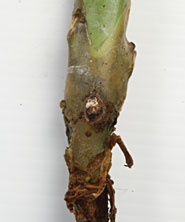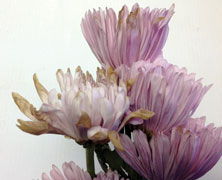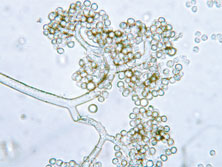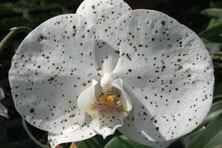10/1/2017
Botrytis Blight on Greenhouse & Nursery Ornamentals
Aaron Palmateer, Ph.D.

Gray mold, or Botrytis blight, is one of the most destructive and economically important diseases affecting greenhouse grown ornamental plants. The disease can also be prevalent on outdoor plantings, including shadehouses and open field nurseries, mostly during or following cool, damp and cloudy conditions.
Botrytis is reported to cause damage on many greenhouse vegetable and fruit crops. Losses due to Botrytis reach far beyond the greenhouse and nursery where the disease is common on plants and plant products during shipping and is frequently an issue for post-harvest storage, even occurring on plant products in cold storage.
Pictured: Brown, water-soaked stem tissue of a coral cactus resulting from early infection by Botrytis cinerea.
Botrytis cinerea is a fungus that has the capability of living on both dead and live plant material, which makes it one of the more challenging plant pathogens to control. It can invade and damage just about any part of the plant, but blight mostly occurs on more tender plant tissues, including the flowers, buds and leaves with weakened and damaged tissue being the most susceptible. Botrytis can quickly invade damaged plant tissue, including freshly cut tissue during pruning and propagation, which frequently results in stem lesions, dieback and has been reported to inhibit rooting on infected cuttings.
Regardless of the plant part infected by Botrytis, the affected tissue appears wet and turns tan to brown in color. Young fuzzy growth appears white to whitish-gray and eventually turns entirely gray. The fungus is very fast growing and capable of producing thousands of spores in grape-like clusters that develop on rotting tissue. These spores are mostly spread by wind and water, but nearly any activity can spread Botrytis spores in a greenhouse.
 Pictured: Daisies maintained in cold storage showing early stages of Botrytis blight on the flower petals.
Pictured: Daisies maintained in cold storage showing early stages of Botrytis blight on the flower petals.
Botrytis is often considered a cool-weather pathogen and disease development is most often favored by cool and damp conditions with temperatures in the 70s and relative humidity at 90% or greater. Free moisture or high relative humidity is necessary for spore germination, so allowing the foliage to dry will help minimize disease.
The fungus can be active at very low temperatures and can cause substantial loss of plant products in cold storage ranging from 32 to 50F (0 to 10C). Most cold storage units are maintained with high relative humidity to prevent shrinking or shriveling of plant material, so it’s very important to maintain strict sanitary measures and use fungicides preventatively when conditions are favorable.
Botrytis requires direct contact with open wounds or an available food source, such as diseased flower petals or pieces of debris that come into contact with healthy plant tissues for the infection process to begin. The Botrytis-infected tissue serves as a potential source of inoculum, providing a substrate that the mycelium grows from and then penetrates underlying healthy plant tissue. This illustrates the importance of strict sanitation practices that includes removing and discarding dead blooms, leaves and all plant debris found on or under greenhouse benches and in plant beds.
When it comes to effective management of prolific pathogens such as Botrytis, preventative fungicide applications are a must. It’s critical that individuals making fungicide application decisions follow the manufacturer’s recommendation for proper rates and application intervals. Several fungicides have been developed for use on ornamental plants for controlling Botrytis (refer to table).
 Pictured: A conidiophore of Botrytis cinerea producing characteristic “grape-like” clusters of conidia.
Pictured: A conidiophore of Botrytis cinerea producing characteristic “grape-like” clusters of conidia.
The proper use of fungicides and recognizing the importance of rotating the Fungicide Resistance Action Committee (FRAC) groups for control of economically important plant diseases such as Botrytis blight will ensure long-term success and future availability of fungicides for disease management.
Botrytis cinerea has been reported as a high-risk pathogen for its potential to develop fungicide resistance by FRAC. The high-risk category includes fungal plant pathogens that have evolved resistance to fungicides in a sufficiently short time frame (e.g., within a few cropping seasons) and where there are documented cases of resistance to more than one class of fungicide.
Botrytis is infamous for developing resistance to fungicides and a quick review of the scientific literature will produce numerous reports of fungicide resistant isolates and often isolates that have developed resistance to multiple classes of fungicides. However, this most certainly doesn’t imply that all populations of Botrytis are resistant to fungicides and growers should consult their local extension specialist for updates on Botrytis outbreaks in their area.
 Pictured: Symptoms of Botrytis blight on a phalaenopsis orchid flower.
Pictured: Symptoms of Botrytis blight on a phalaenopsis orchid flower.
Bayer will soon be introducing a fungicide containing fluopyram, a new chemical group, which offers another tool for fungicide resistance management. Fluopyram will be combined with trifloxystrobin (FRAC 7+11) and this unique combination has shown to be highly effective against Botrytis and many other fungal plant pathogens affecting ornamentals. The new Bayer fungicide Broadform will be available in 2018.
GT
Not all products are registered in all states. Check with your local sales rep for availability. Always read and follow label instructions.
Dr. Aaron Palmateer is Green Solutions Team/Senior Technical Services Representative for Bayer.